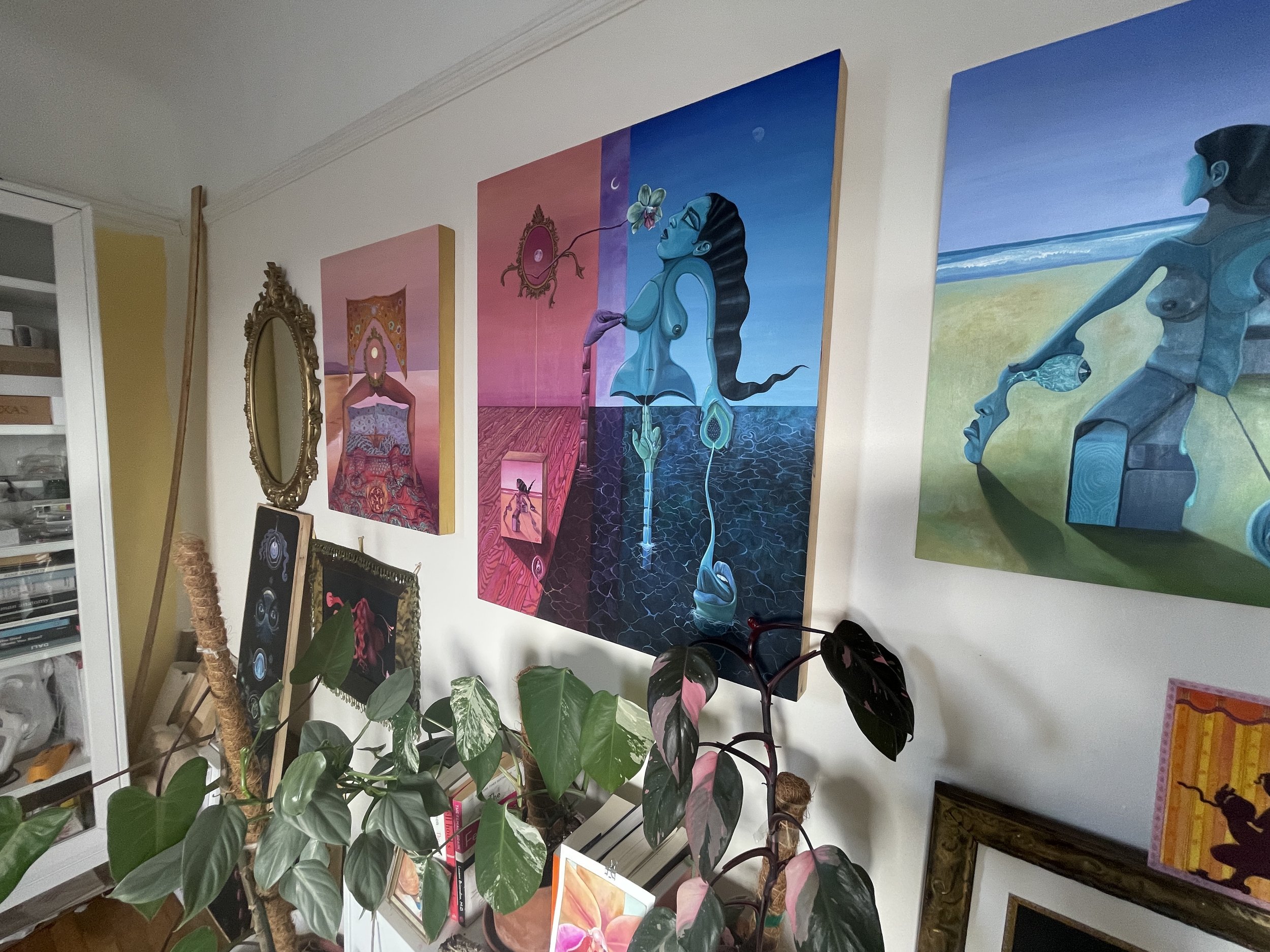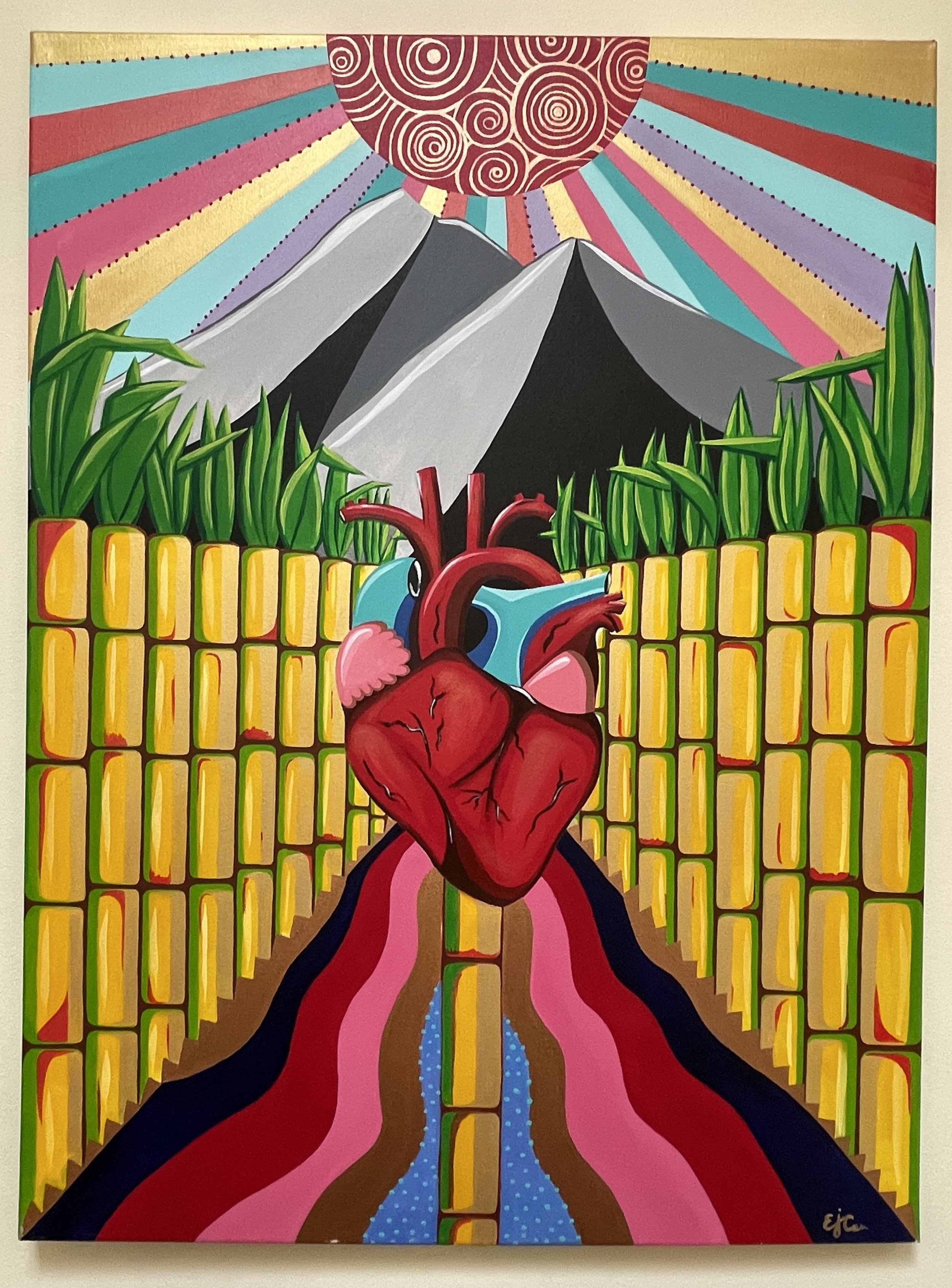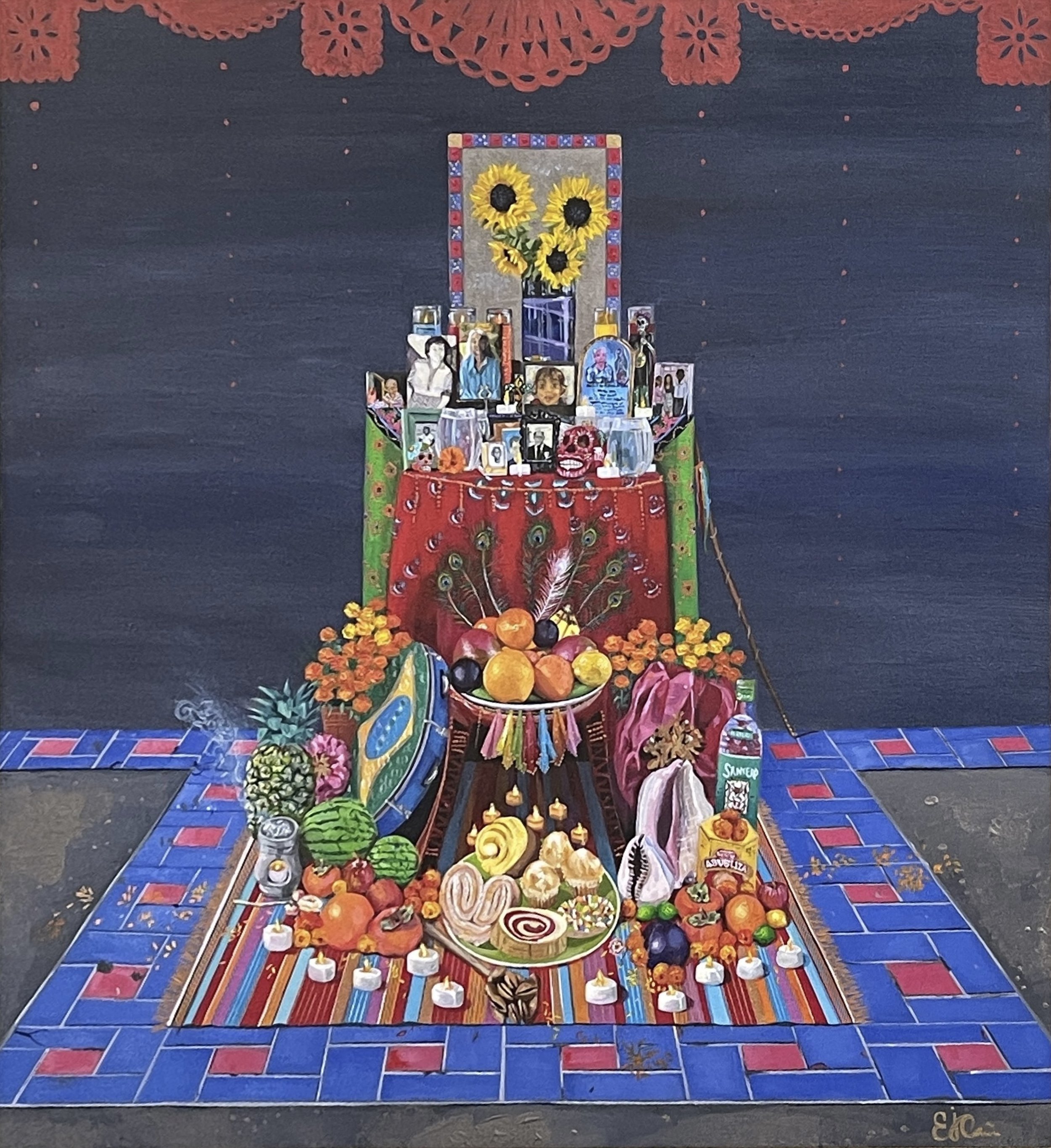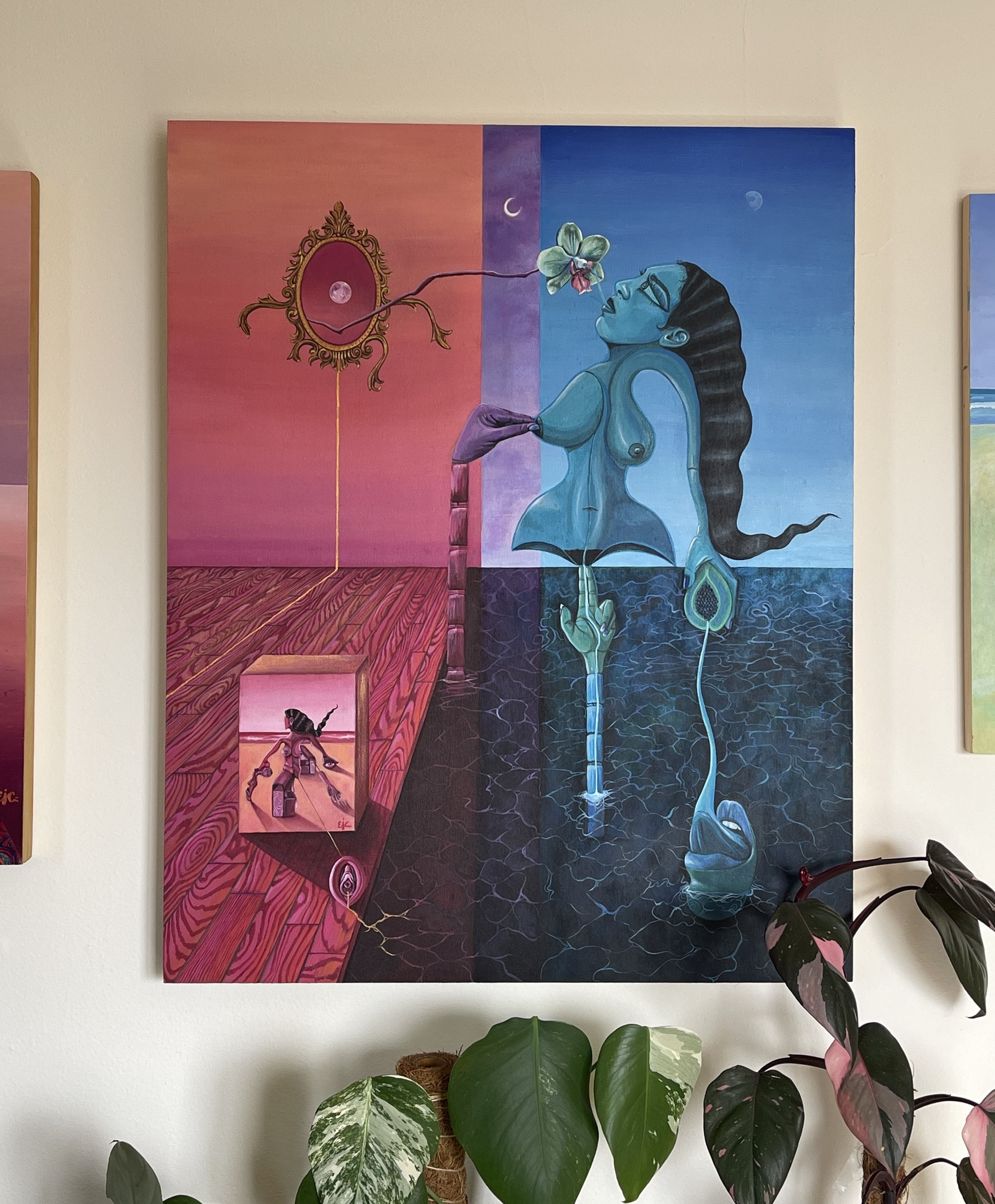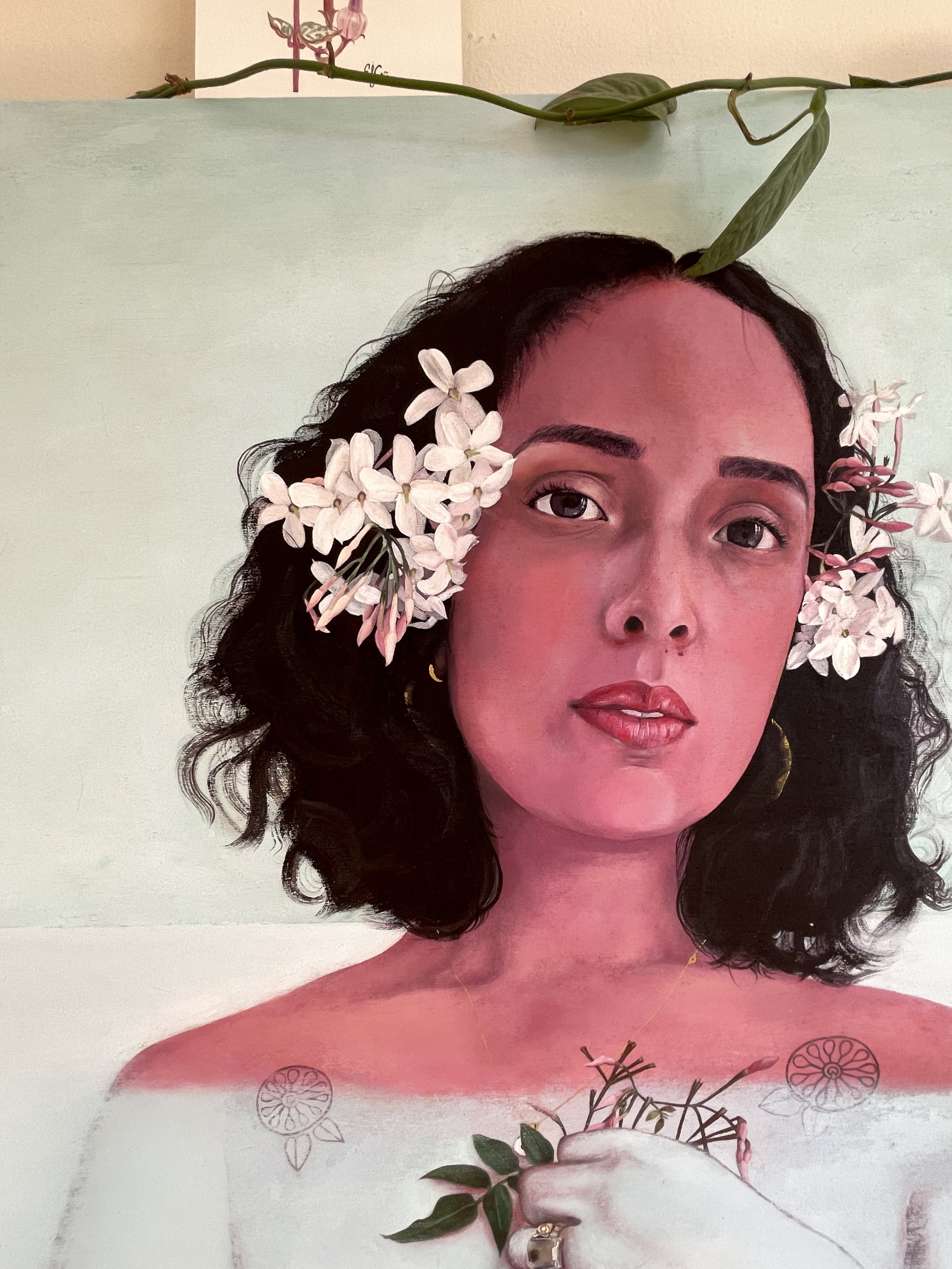Studio Visit & Interview with Jasmin Cañas
By John Vochatzer
Jasmin Cañas is an artist of whom I’ve only personally come to discover very recently, and surprisingly considering the level of skill, prolificness, and utter genuineness she’s been churning out work right here in San Francisco. She is a magician of sorts—transmuting her life experiences and her traumas into art through a very refined, classical surrealist lens that’s steeped in the colorful influences that accompanied her growing up in the Mission District. A vibrant neighborhood that’s been historically rich with Latinx culture, muralism, activism, and underground subcultures—I would even venture as far as to say that Jasmin’s work is one of the most acute embodiments of this very magical place that I can imagine coming from a single artist.
Sharing a home studio with her husband Sergio who is also a painter and a musician, and her toddler son Marcelo who is already exhibiting a natural gift for the arts—Jasmin works diligently with a wide range of skill sets to create some of the most deeply personal and cathartic work I’ve seen in recent memory. The works Jasmin creates function both as introspective diary entries and as extensions of her own mental and spiritual being, and this deep connection to her work is illustrated by the difficult time she has parting with her finished pieces. Apart from the more intimate nature of her recent work, Jasmin’s art also comes charged with the strength and resilience of Latinx peoples and of The Mission in particular—a neighborhood that has also become famous for it’s struggle against encroaching displacement in the past 15 years.
While I believe that something that makes San Francisco so special is it’s magnetism for artists and creatives from all around the world, it’s conversely always refreshing finding an artist of such great caliber forged entirely here and in the heart of the city itself. Many such artists were pushed or forced out as a result of the tech boom and the proceeding gentrification, and I think it’s integral that as a creative community we celebrate and give voice to those that have continued to hold on. I’m very excited to see where Jasmin goes on her path as an artist, and I’m proud to live in a place that gives birth to such rich and creative talent.
Interview
Hi Jasmin! Thanks for letting me come check out your lovely home and studio. For those who don’t know you, can you tell us a little bit about who you are and the type of work that you do?
Thanks so much for stopping by!
I’m a painter struggling to balance the simultaneous roles of being a mother/artist. I work mainly with acrylic paint on wooden panels or gouache on paper. The most authentic way to translate my thoughts into paintings is through Surrealism, and my subject matter, for the past five years, has been my lovely self and my experiences in this life.
I spend most of my days creating in my studio with my toddler while my chunky cat, Gala, judges us from her favorite chair.
I was born and raised in San Francisco and lived most of my life in the Mission district. A lot of my artistic influences stem from growing up in this neighborhood.
What were your earliest roots as an artist? And do you come from a creative family?
My dad’s side of the family has all the painters. My household wasn't particularly creative though. I was the only doodler in the house. However, the walls in my home were covered from floor to ceiling with colorful art and souvenirs from all of central America, and Mexico, as well as a random collection of impressionist paintings my mom inherited from all the rich folk’s homes she cleaned. Those visual influences as well as the privilege of living in a mural covered neighborhood, had a stronger wiring of my artistic brain than any genetic gift passed down through blood.
You also share your home and studio with your husband Sergio, and your son Marcelo. What’s it like living in such an artistic household and how do the three of your creative energies play off of each other?
It’s a fun house! Everything is art and It’s always a team effort.
I feel pretty lucky to be married to a painter. We’re each other’s biggest fans. Although, I do force him to be my biggest critic at times. I tend to check in with him through every phase of my works in progress, and usually respect his opinion and accept his critiques. He always sees what I don't see, and makes me better. Art deepens our union as a couple.
Marcelo’s corner of the studio.
My son has been obsessed with drawing and painting for about a year now. He usually wakes in the morning, or from a nap, saying “pinta” (Paint in Spanish). To him, art is just something we do, like eating, or showering. It’s magical to see him in artistic bliss as he creates.
It was interesting to learn you studied fashion at FIDM here in San Francisco. How did your interests in fashion first arise? And does your study of fashion inform the work you do currently?
I grew up wearing hand-me-downs. I think it was around age 14 that I started wanting to express myself through fashion a lot more so I started altering old clothes to make my own designs. I was also super blessed to grow up two doors down from Fabric Outlet between 17th and 18th and Mission. I was always in there rummaging through fabrics and hardware to make a new outfit. It felt natural to study Fashion right out of high school. By the time I graduated from FIDM, I was completely turned off by the fashion industry though, so I never pursued a career in that field.
I know I’ve retained a lot of the technical skills of fashion sketching and color theory lessons, but I think the one piece of knowledge that informs my current work would be collection building. Fashion designers create in collections. I don't think I’ve stuck to a particular style of painting over the years. I’ve always visualized my paintings as part of a family of few that compliment each other. Once a collection of paintings feels complete, I move on to a different collection that evolves my style.
I’d love to explore different ways to use my fabric and design knowledge to create something visual that isn't wearable.
You grew up mostly in the Mission District here in SF, how would you describe the Mission to someone who has never been there or visited San Francisco before?
I can only describe this place through my native filter.
To me, the Mission is an explosion of color, sounds, flavors, cultures, activism, pain and resiliency. It’s overstimulating, in a good way. Its mural’s are a visual way to convey social and political issues and capture the vibrant people that live in that community. The people that love the Mission, love it together, and fiercely. It’s a powerful place.
You mentioned how much your adolescence in the Mission inspires the art you make, and it’s often very prevalent, but can you describe in your own words how these influences permeate your work?
Mission muralism is what formed my style at the beginning. It definitely inspired my earlier work through subject matter, color pallet, and meaning. The Mission breeds “Artivism,” and that for sure is seen in a lot of my work.
Although my art is very personal today, my artistic voice still wants to be powerful and tell a story of struggle and strength, just like the artists in that community do. I’m just now digging deeper into generational and personal trauma to heal myself, instead of giving myself artistically to heal a community.
It was cool seeing the wide range of painting styles you’ve explored, including some very impressive hyper-realism. My favorite however is your surrealist work—how did you first get into surrealism and who are some of your influences in that field?
I was a surrealist before I ever attempted any other genre of painting. It wasn't till 2019 that I reconnected with surrealism. It’s honestly the only authentic way to visualize and concretize the type of topics I want to convey. This genre allows me to paint feelings, moods, and the parts of my human experience that confuse me the most. It helps me make sense of the things I just can't communicate in words. It’s magic.
The works of Remedios Varo and Rene Magritte challenged my mind the most. They are my top surrealist crushes.
Your work is very personal and explores a lot of themes such as motherhood, trauma, and bi-sexuality that are concurrent with your life and your identity, how do you use your art to explore these things? And what kind of catharsis do you receive from the creative process?
Every piece I've painted, since 2019, is a page in my diary. There are many aspects of my human experience that I'm uncomfortable with, or that are so magical, that I don't have words to translate them. Painting helps me make sense of some of that, and if I can't make sense of it, at least I recorded it, so I can stare at it with the hopes of someday making sense of it. Since becoming a mother, there is a massive backlog of paintings stored in me just waiting to come out. An idea for a painting is always a nagging thought, story, or feeling that wants to be concrete. Completing a painting is a definite sigh of relief.
It was also very interesting learning about your spiritual practice of Lucumí, and about the year-long Ocha initiation that you underwent. Can you tell us a little bit about this?
Lucumi is an African tradition that came over to Cuba. There are many ways to practice it. Ocha is an initiation ceremony that gives us sacred knowledge and power gifted by the deities who embody nature and created earth. The yearlong spiritual cleanse that tags along to the initial Ocha ceremony, restricts you to so much of the worldly pleasures we’re accustomed to, but it allows us to look within. It’s a quiet year…a challenging year… It's a rebirth. I’d do it all over again today if I could.
The last major exhibit you had was “Ode to Our Barrio” at Accion Latina, alongside Natalie Alemán in 2018. Can you tell us a little bit about that exhibit? And what’s next and where would you like to be going with your work?
The idea for “Ode to Our Barrio” started with me trying to challenge myself artistically by attempting to paint hyper realistic paintings of photographs Natalie was taking of our neighborhood, the Mission. It then evolved into an incredibly meaningful documentation of all things, that in our hearts, was the spirit of the Mission. Looking back I can understand we were really just making a record of a feeling only a native can feel for home.
I'm enjoying painting for myself and about myself now. I’m my own muse and it’s challenging me more than ever. Now that I’m both mother and artist, I’ve prioritized using my art as a healing tool. I want to be a happy mother/artist for myself and for my son.
Through motherhood, I’ve made many inspiring friendships and connections that I want to honor through a series of paintings that capture the fierceness and fear behind being someone’s mom. That series is already in the works and I hope to have it complete in about a year :)
Gracias!!!

